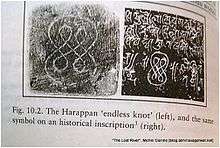Harappan language
| Harappan | |
|---|---|
| Indus Valley, Mohenjo-Daro | |
| Region | Indus Valley |
| Extinct | 1900 BCE? |
| Language codes | |
| ISO 639-3 |
xiv |
Linguist list |
xiv |
| Glottolog | None |
The Harappan language (AKA the Indus or Mohenjo-Daro language) is the unknown language or languages of the Bronze Age (2nd millennium BCE) Harappan civilization (Indus Valley Civilization, or 'IVC'). The language being unattested in any readable contemporary source, hypotheses regarding its nature are reduced to purported loanwords and substratum influence, notably the substratum in Vedic Sanskrit and a few terms recorded in Sumerian cuneiform (such as Meluhha), in conjunction with analyses of the undeciphered Indus script.
There is a handful of possible loanwords from the language of the Indus Valley Civilization. Sumerian Meluhha may be derived from a native term for the Indus Valley Civilization, also reflected in Sanskrit mleccha, and Witzel (2000) further suggests that Sumerian GIŠšimmar (a type of tree) may be cognate to Rigvedic śimbala and śalmali (also names of trees).[1]
Identification

There are a number of hypotheses as to the nature of this unknown language:
- The hypothesis places it in the vicinity of Dravidian, perhaps identical with Proto-Dravidian itself. Proposed by Henry Heras in the 1950s,[2] the hypothesis has gained plausibility and is endorsed by Kamil Zvelebil, Asko Parpola and Iravatham Mahadevan.[3][4]
- Michael Witzel as an alternative suggests an underlying, prefixing language that is similar to Austroasiatic, notably Khasi; he calls it "para-Munda" (i.e. a language related to the Munda subgroup or other Austroasiatic languages, but not strictly descended from the last common predecessor of the contemporary Munda family). Witzel argues that the Rigveda shows signs of this hypothetical Harappan influence in the earliest historic level, and Dravidian only in later levels, suggesting that speakers of Austroasiatic were the original inhabitants of Punjab and that the Indo-Aryans encountered speakers of Dravidian only in later times.[5][6]
- a "lost phylum", i.e. a language with no living continuants (or perhaps a last living reflex in the moribund Nihali language). In this case, the only trace left by the language of the Indus Valley Civilization would be historical substratum influence, in particular the substratum in Vedic Sanskrit.
Hypotheses that have gained less mainstream academic acceptance include:
- an Indo-European language, close or identical to Proto-Indo-Iranian: suggested by archaeologist Shikaripura Ranganatha Rao.[7]
- a Semitic language: Malati Shendge (1997) identified the Harappan culture with an "Asura" empire, and these Asura further with the Assyrians.[8]
Multiple languages
The Indus script indicates that it was used to write only one language (if at all). But it is quite possible that multiple languages were spoken in the IVC, similar to how Sumerian and Akkadian co-existed in Mesopotamia for centuries. Jane R. McIntosh suggests one such possibility: Para-Munda was originally the main language of the civilization, especially in the Punjab region. Later, the proto-Dravidian immigrants introduced their language to the area in 5th millennium BCE. The Dravidian language was spoken by the new settlers in the southern plains, while Para-Munda remained the main language of those in Punjab.[9]
References
- ↑ An Indus loanword of "para-Munda" nature in Mesopotamian has been identified by Michael Witzel, A first link between the Rgvedic Panjab and Mesopotamia: śimbala/śalmali, and GIŠšimmar? In: Klaus Karttunen and Petteri Koskikallio (eds.) Vidyarnavavandanam. Essays in Honour of Asko Parpola. 2000 (Studia Orientalia, published by the Finnish Or. Soc. 94): 497-508. See also Witzel, The language or languages of the Indus civilization, July 2007.
- ↑ Heras, Henry. Studies in Proto-Indo-Mediterranean Culture, Bombay: Indian Historical Research Institute, 1953.
- ↑ Rahman, Tariq. "Peoples and languages in pre-islamic Indus valley". Archived from the original on 2008-05-09. Retrieved 2008-11-20.
who was the first to suggest that the language of the Indus Civilization was Dravidian
- ↑ Cole, Jennifer. "The Sindhi language" (PDF). Archived from the original (PDF) on January 6, 2007. Retrieved 2008-11-20.
Harappan language, the ancient script is as yet undeciphered, but a prevailing theory suggests a Dravidian origin.
- ↑ Witzel, Michael (2000-02-17). "The Languages of Harappa" (PDF). In Kenoyer, J. Proceedings of the conference on the Indus civilization. Madison. Retrieved 2007-07-18.
- ↑ Michael Witzel, Substrate Languages in Old Indo-Aryan. EJVS 5,1, Aug. 1999, 1-67 cf. reprint in: International Journal of Dravidian Linguistics, IJDL 2001, 1 sqq.
- ↑ Indo-Iranian presence is likely only from the Late Harappan period (20th century BCE) at the earliest; see e.g. Parpola, Asko (1999). "The formation of the Aryan branch of Indo-European". In Blench, Roger; Spriggs, Matthew. Archaeology and Language. III: Artefacts, languages and texts. London and New York: Routledge.
- ↑ Malati Shendge, The Language of the Harappans Abhinav Publications (1997), ISBN 978-81-7017-325-0.
- ↑ McIntosh 2008, p. 355-356.
Further reading
- Austin Patrick Olivelle. Between the Empires : Society in India 300 BCE to 400 CE: Society in India 300 BCE to 400 CE. Oxford University Press.
- McIntosh, Jane R. (2008). The Ancient Indus Valley : New Perspectives. Santa Barbara, California: ABC-CLIO. ISBN 9781576079072.